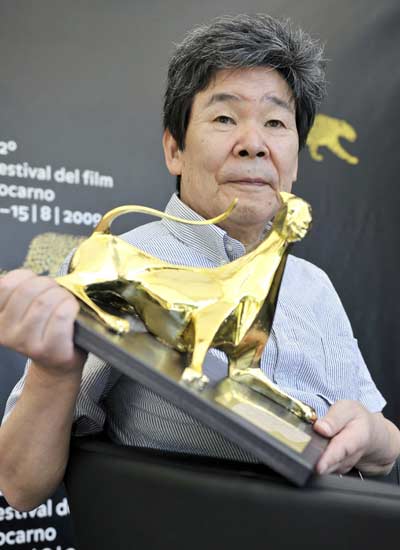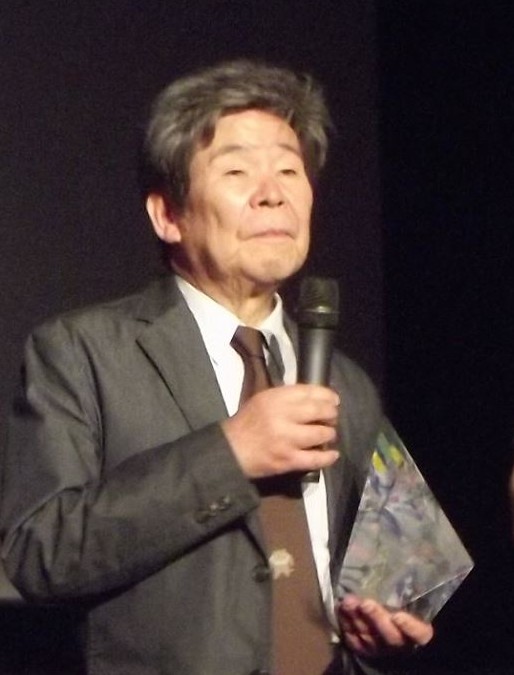<Back to Index>
- Anime Filmmaker Isao Takahata, 1935
PAGE SPONSOR


Isao Takahata (高畑 勲 Takahata Isao, October 29, 1935 - April 5, 2018) was a Japanese anime filmmaker that earned critical international acclaim for his work as a director. Takahata was co-founder of Studio Ghibli with long time collaborative partner Hayao Miyazaki. He was the director of films such as the war themed Grave of the Fireflies, the romantic drama Only Yesterday, the ecological adventure Pom Poko and the comedy My Neighbors the Yamadas. Of these Grave of the Fireflies was considered by film critic Roger Ebert one of the greatest war films ever made. Unlike most anime directors, Takahata never worked as an animator before becoming a full fledged director.
According to Hayao Miyazaki, "Music and study are his hobbies". He was born in the same town as fellow director Kon Ichikawa, while Japanese film giant Yasujiro Ozu was raised by his father in nearby Matsusaka.
Takahata graduated from the University of Tokyo French literature course in 1959.
Takahata was originally intrigued by animation after having seen the French animated cartoon feature Le Roi et l'oiseau (The King and the Mockingbird) based on the fairy tale by Hans Christian Andersen. He was impressed by the film, asking "Can these kind of things be done by animation?"
While he was job hunting at his university, Takahata was tempted to join Toei Animation by a friend who knew the company wanted an assistant director. For fun he took the company's entrance examination as he had been originally interested in animation. When he was notified of the informal decision, he joined the company.
The reason he decided to join the company was his thought that "If it was animation, I can be something interesting, too." However, there were more than ten people joining the company that same year, two recruited by Toei Animation and the surplus workers sent by Toei head office. Because of the competition, he had a hard time achieving the status of director.
Takahata finally directed his first film after he was recommended for the spot by Yasuo Ōtsuka, who was both his and Hayao Miyazaki's instructor. His directorial debut was Hols: Prince of the Sun. Hols was a commercial failure. He was among the production team deemed responsible for the failure and was accordingly demoted. He also had difficulty making a new film as the remaining staff members who had not been demoted for Hols were working on a different Toei film.
In 1971, to make the animated feature Pippi Longstocking, Takahata left Toei Animation with Yoichi Kotabe and Hayao Miyazaki and transferred to "A Production" (present: Shin-Ei Animation), an animation studio founded by his former superior, Daikichiro Kusube (楠部大吉郎 くすべ だいきちろう). They traveled to Sweden to acquire the animation rights and to hunt for locations, only to be turned away at the door by author Astrid Lindgren. Though their plan was frustrated, Miyazaki found inspiration in the fortified town of Visby and would later set both Stockholm and Visby as the stage of Kiki's Delivery Service.
In 1971, Takahata and Miyazaki requested to direct episodes seven and onward of the first Lupin III TV series anime, due to the low ratings and, for the time, exceptionally high levels of sex and violence in the initial episodes directed by Masaaki Osumi. Since the animation director was Yasuo Ōtsuka, an old acquaintance, they accepted the offer under the condition that "the names of the two people were not released, and direction was credited only to 'A production directors group.'" Unlike Miyazaki, he did not participate in the second series, though his directing in the original was well received.
Later in 1971 Zuiyo Enterprise invited Takahata, Kotabe and Miyazaki to direct an animated series of the novel Heidi and all three took the offer. The result was Heidi, Girl of the Alps. Afterward, when the production section of Zuiyo was established as a subsidiary company of the animated cartoon production of Zuiyo Eizo (present: Nippon Animation), they both joined the company. On the picture side, animators drew carefully the nature of Europe and a change of season, and the everyday life of people on location in Switzerland. On the other hand, on the story side, Takahata made the animation version easy to accept by thinning a Christian element of the original besides the earnest Christian (especially, in the latter half).
In the case of 3000 Leagues in Search of Mother, the summary of the story followed the original, but he created many episodes and original characters because the story was less than 100 pages. He expressed the protagonist Marco as a boy of independent spirit who did not flatter adults too much and adults as ones who committed the crime even if they were comparatively good men. He brought the world of this anime close to the reality or more by doing so. However, Kotabe and Miyazaki felt frustrated by his direction and did not feel pleasure even as they drew it, and they left Takahata.
In Anne of Green Gables, Takahata directed it along the original basically, but he was able to deepen an impression about Marilla and Anne by describing it as the para - parenthood which was heavier than the original.
In Jarinko Chie, じゃりん子チエ (meaning Chie the Brat) in 1981, Yasuo Otsuka who belonged to Tokyo Movie Shinsha / Telecom Animation Film Co., Ltd. offered Miyazaki, a Telecom colleague, to make this comic an animated cartoon, but he refused. Therefore, Otsuka consulted Takahata, but he also expressed disapproval first. However, Takahata who had visited Osaka (which was the stage for the story) felt that the world drawn in the comic was actually there. He took the request, left Nippon Animation, and moved to Telecom. This work, which paired Yasuo Otsuka and Yoichi Kotabe, was praised and settled for a TV animation series because it got a favorable reception, and Takahata became the chief director.
In 1982, Takahata was elected the director of Little Nemo — the work that tried to be produced so that Telecom could move to the United States. With Miyazaki and Otsuka, who started at Telecom earlier, Takahata went to America, but the discord between the Japan - U.S. difference in production technique, meant Takahata resigned and left Telecom. Miyazaki and others followed him. On the other hand, a cultural exchange was born between the Japanese animator and seniors of Disney who had been cooperating in this project.
Afterward, Takahata was invited by Miyazaki to join his animation production company Studio Ghibli after the success of Miyazaki's Nausicaä of the Valley of the Wind. The first movie directed by Takahata for Ghibli was Grave of the Fireflies. It got good reviews in foreign countries partly because it was taken up by Roger Ebert.
In Kiki's Delivery Service, Takahata did the music direction for Miyazaki.
Takahata was awarded the Special Award at the Kobe Animation Awards on November 4, 2007.
Takahata announced that he would direct one last film for Studio Ghibli, The Tale of the Princess Kaguya (Kaguya-hime no Monogatari, 2013), around the same time that Miyazaki also announced his plans to retire from the studio. "Someday we should make a Japanese Heidi" Takahata and Miyazaki had both agreed after making Heidi noting its similarities to The Princess Kaguya story. Heidi's carefree depiction, Takahata had told one journalist, "stems from my ideal image of what a child should be like". When the film arrived in Western markets the following year, it was nominated for the Best Animated Feature at the 87th Academy Awards. Takahata continued to work at Ghibli, serving as an artistic producer for The Red Turtle (2016), the first feature film of Dutch animator and director Michaël Dudok de Wit in collaboration with Ghibli. The film premiered in September 2016.
Takahata had been diagnosed with lung cancer, and died on April 5, 2018, at a hospital in Tokyo, at the age of 82. On May 15, 2018, a farewell ceremony for Takahata was held at the Ghibli Museum in Tokyo. Hayao Miyazaki publicly spoke for the first time about Takahata's death, saying "I was convinced that Paku-san [Takahata's nickname] would live to be 95 years old, but he unfortunately passed away. It makes me think my time is also limited...Thank you, Paku-san."
Takahata has been influenced by Italian neorealism, Jacques Prévert and French New Wave films during the 1960s. Bicycle Thieves has been cited as specifically influencing 3000 Leagues in Search of Mother. These influences make Takahata's work different from most animation, which focus on fantasy. His films, by contrast, are realistic with expressionistic overtones.
Neo - realism's influence on his film is evident in the amount of attention to detail he takes in displaying everyday mundane events. Entire episodes of his early TV shows were devoted to looking at events such as going to church every week, having a job cleaning out bottles, or detailing the work farmers do out in fields. All of these events are shown in meticulous detail and often form a major part of his work. With the exception of Horus: Prince of the Sun (a Disney - esque musical with darker and more political overtones), Pom Poko (an environmentalist film about magical tanuki trying to save their land), and Gauche the Cellist (a film about a struggling cellist who is helped by talking forest animals), the majority of his works are dramas set in mostly realistic environments.
One of Takahatas' most praised films is Omohide Poro Poro (literally, 'Memories Like Falling Raindrops'). The film was released in 1991 in Japan to critical acclaim, and was re-titled as Only Yesterday for release to English speaking audiences. A film aimed squarely at an adult audience, Omohide Poro Poro revolves around Taeko, a single woman working a desk job in Tokyo, who takes her annual vacation in the countryside with the family of her brother - in - law to work as a farmhand. During her holiday, Taeko finds herself looking back nostalgically at her youth as a schoolgirl growing up in 1966, while simultaneously attempting to resolve her current issues with love and career.
The expressionistic influences in Takahata's work are usually marked by scenes where a character's imagination comes to life on screen. For instance, in Omohide Poro Poro, after Taeko encounters her first love she, defying gravity, runs up into and floats through the red colored sky. The scene ends with her slowly gliding into bed and then cuts to an outside shot of her house where a giant heart emerges from her window. These expressionistic sequences run counter to Takahata's realistic storyline and animation, but are consciously used by the director to transition back and forth from realism to the unreal world of animated fantasy, thereby further enhancing the character. These scenes can be found to some degree in all of Takahata's work, beginning with the "forest of delusion" sequence in Horus: Prince of the Sun.
Takahata's films have had a major influence on Hayao Miyazaki, prompting animator Yasuo Ōtsuka to say that Miyazaki gets his sense of social responsibility from Takahata and that without Takahata, Miyazaki would probably just be interested in comic book stuff.
As with Miyazaki, Takahata and Michel Ocelot were great admirers of each other's work. Ocelot named Takahata's Grave of the Fireflies and Pom Poko among his favorite films, while Takahata used Ocelot's Kirikou and the Sorceress as a key example of objectivity used to a positive effect, as well as adapting and directing the Japanese dubs of his films.